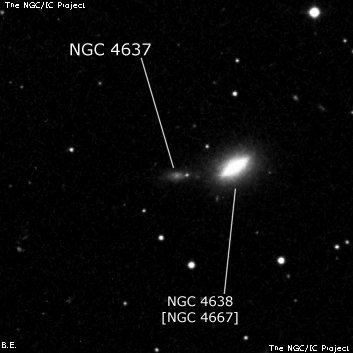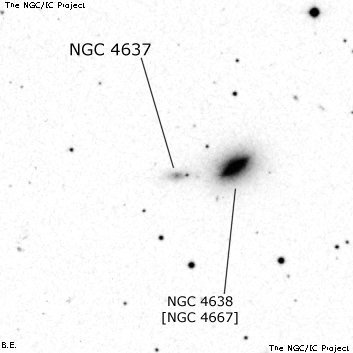NGC/IC Project Restoration Effort
(This is a very very beta version)
NGC4637


Basic Information
Location and Magnitude
Right Ascension: 12:42:54.2
Declination: +11:26:17
Constellation: VIR
Visual Magnitude: 13.9
Historic Information
Discoverer: Mitchell
Year of discovery: 1854
Discovery aperture: 72.0
Observational
Summary description: Makes a D neb with h 1402 (?)
Sub-type: S0
Corwin's Notes
=====
NGC 4637 and NGC 4638. The brighter of the two galaxies now carrying these
numbers was found by WH (he actually found it twice, so it has two entries in
his catalogue). The fainter, a much smaller spiral of fairly low surface
brightness with a faint star superposed west of the nucleus, was seen only
once in 1854 by Lord Rosse (or his observer), who noted only a "Double
nebula; faint nebulosity connects them." Given this sparce description,
Dreyer assigned an approximate position to the fainter and called it NGC 4637,
giving NGC 4638 to WH's brighter object. He also added a note in the NGC
suggesting that Lord Rosse had actually seen M 60 (NGC 4649) and NGC 4647,
which are just 12 arcmin northeast. This would explain why no other observers
(aside from LdR and Herman Schultz) recorded the object as a double nebula.
Schultz's observation is an interesting one. He has an extensive note in
which he claims that the nebula is clearly double (in spite of relatively poor
seeing on the night of observation), nearly on the parallel, and with a star
of 10th magnitude north-preceding (which there indeed is; there is no such
star north-preceding N4647 and M 60). Like LdR, he says nothing about the
relative brightness of the objects, but records his surprise that neither of
the Herschel's noticed that the object was double and extended. Curiously, he
gives measurements (on two different nights) of only one of the nebulae,
though he specifically mentions that the micrometer wire, aligned with the
equator, nearly bisected both objects. His reduced position is that of NGC
4638, the brighter object.
In his Virgo Cluster survey, Schwassmann listed only one object here and
assigned it the first NGC number of the pair. His description fits the
brighter object, however, and he noted that the identity was uncertain and
that the object could be NGC 4638 instead. His position is peculiar, too: the
RA is that of the fainter eastern galaxy, while the declination is that of the
brighter western object. Remembering that Schwassmann's plate was taken with
a 6-inch lens, I suspect that the plate recorded only the brighter object and
that Schwassmann made a measurement or reduction error in his RA.
Dreyer, however, had only Schwassmann's entry to go on, not a modern sky
survey. So, he could not know about the potential problems in the Heidelberg
observation. Thus, he adopted Schwassmann's observation as applying to the
fainter object, and put a note in IC2 to that effect.
My own guess, without Schultz's confirmation of the duplicity of the object,
would have been that Dreyer was correct in his supposition about LdR having
misidentified the objects he observed in 1854. If this is the case, then NGC
4637 is a reobservation of NGC 4647 (found by JH) rather than the very faint
companion to NGC 4638. However, Schultz's observation seems to clearly point
not to M 60 and its companion, but to N4638 and its companion.
Still, LdR and Schultz could have seen the fainter object -- both have others
just as faint in their lists -- especially since it is enhanced by the
superposed star, so the "classic" numbering for this pair of galaxies is
still a possibility. I should note, too, that there has been some confusion
in the modern catalogues as to which number applies to which object. Dreyer
unfortunately confused the issue a bit with his IC2 note, and also with his
original numbering: JH had the fainter companion coming second in the GC.
Nevertheless, Dreyer clearly meant NGC 4638 to apply to WH's object, so that
is the identification I've adopted, leaving NGC 4637 as probably applying to
the faint companion -- or possibly to NGC 4647.
Steve's Notes
=====
NGC 4637
24" (5/25/14): at 225x, this companion to NGC 4638 appeared extremely faint, fairly small, elongated 5:2 E-W, ~25"x10". Required averted vision and could not hold for fairly brief intervals. Located 1.6' E of the center of NGC 4638. The identification of this number is uncertain and it may be a duplicate of NGC 4647.



